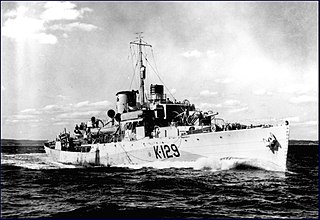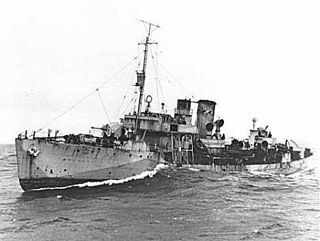
HMCS Sackville is a Flower-class corvette that served in the Royal Canadian Navy and later served as a civilian research vessel. She is now a museum ship located in Halifax, Nova Scotia, and the last surviving Flower-class corvette.

HMCS Alberni was a Flower-class corvette that served in the Royal Canadian Navy (RCN) during the Second World War. The Flower-class corvettes were warships designed for anti-submarine warfare. The ship was constructed by Yarrows Ltd. in Esquimalt, British Columbia, laid down on 19 April 1940, launched on 22 August and commissioned on 4 February 1941. The corvette sailed east to join the RCN's fleet in the Atlantic via the Panama Canal, where upon arrival, the vessel began escorting trans-atlantic convoys in the Battle of the Atlantic. Alberni took part in the key convoy battle of Convoy SC 42. In 1942, the corvette was transferred to Allied convoy assignments associated with Operation Torch in the Mediterranean Sea. In 1944, Alberni was among the Canadian naval vessels assigned to Operation Neptune, the naval component of the invasion of Normandy and escorted support ships to and from the United Kingdom on D-day.

Mid-Ocean Escort Force (MOEF) referred to the organisation of anti-submarine escorts for World War II trade convoys between Canada and Newfoundland, and the British Isles. The allocation of United States, British and Canadian escorts to these convoys reflected preferences of the United States upon United States' declaration of war and the organisation persisted through the winter of 1942–43 despite withdrawal of United States ships from the escort groups. By the summer of 1943, United States Atlantic escorts were focused on the faster CU convoys and the UG convoys between Chesapeake Bay and the Mediterranean Sea; and only British and Canadian escorts remained on the HX, SC and ON convoys.
HMS Arabis was a Flower-class corvette of the Royal Navy. The ship was commissioned into the Royal Navy as HMS Arabis. She was transferred to the United States Navy in 1942, serving as USS Saucy. Returned to the United Kingdom in 1945, she was recommissioned into the Royal Navy as HMS Snapdragon.

HMCS Wetaskiwin was a Flower-class corvette of the Royal Canadian Navy that served during the Second World War. She served primarily as a convoy escort in the Battle of the Atlantic. She was named after the city of Wetaskiwin, Alberta. Wetaskiwin was the first Pacific coast built corvette to enter service with the Royal Canadian Navy.

HMCS Galt was a Flower-class corvette of the Royal Canadian Navy that served during the Second World War. She saw action primarily in the Battle of the Atlantic. She was named after the city of Galt, Ontario.

HMCS Agassiz was a Flower-class corvette of the Royal Canadian Navy. Named after the community of Agassiz, British Columbia, the ship was constructed by Burrard Dry Dock Co. Ltd. in North Vancouver, British Columbia and was launched on 15 August 1940. The corvette was commissioned on 23 January 1941 in Vancouver, British Columbia. The Flower class were initially designed for coastal service during the Second World War, but due to the demands of the Battle of the Atlantic, Agassiz was used primarily as an ocean escort for convoys crossing the Atlantic Ocean in engagements with German submarines. Following the war, the corvette was sold for scrap.

HMCS Eyebright was a Flower-class corvette that served mainly with the Royal Canadian Navy during the Second World War in the Battle of the Atlantic. She was named after the medicinal flowering plant genus Euphrasia.

HMCS Battleford was a Flower-class corvette of the Royal Canadian Navy launched on 15 April 1940 and commissioned on 31 July 1941 during the Second World War. The corvette served primarily in the Battle of the Atlantic, escorting convoys of merchant ships. After the war she was sold to the Venezuelan Navy and renamed Libertad. Libertad was wrecked on 12 April 1949.

HMCS Chilliwack was a Flower-class corvette who served with the Royal Canadian Navy during the Second World War. She saw action primarily in the Battle of the Atlantic as a convoy escort. She was named for Chilliwack, British Columbia.

HMCS Amherst was a Flower-class corvette of the Royal Canadian Navy. She served primarily in the Battle of the Atlantic on convoy protection duty during the Second World War. She was named for Amherst, Nova Scotia. The ship was laid down at Saint John Dry Dock and Shipbuilding Co. Ltd. in Saint John, New Brunswick, on 23 May 1940 and launched on 3 December later that year. Amherst was commissioned on 5 August 1941 and served in the Battle of the Atlantic and Battle of the St. Lawrence, earning battle honours for both actions. After the war, the ship was decommissioned and sold to Venezuelan Navy in 1945 and renamed Carabobo. However, while en route to Venezuela, the ship was wrecked in the Gulf of St. Lawrence that same year.

HMCS Drummondville was a Bangor-class minesweeper that served with the Royal Canadian Navy during the Second World War. She saw action primarily in the Battle of the Atlantic. Entering service in 1941, she was sold for mercantile service after the war. In 1963, as Fort Albany, the ship was involved in a collision near Sorel, Quebec and sank. The ship was later raised and broken up.

HMCS Algoma was a Flower-class corvette that served with the Royal Canadian Navy in the Second World War. Named for the Algoma District of Ontario, it served primarily in the Battle of the Atlantic. After the war it was sold to the Venezuelan Navy and renamed Constitución.
HMCS Clayoquot was a Bangor-class minesweeper that served with the Royal Canadian Navy during the Second World War. She saw action mainly in the Battle of the Atlantic. She was sunk in 1944. The minesweeper was named after Clayoquot Sound on Vancouver Island, British Columbia.
HMCS Chedabucto was a Bangor-class minesweeper that served with the Royal Canadian Navy during the Second World War. She served primarily in the Battle of the Atlantic. During the Battle of the St. Lawrence in 1943, Chedabucto was sunk in a collision with a cable ship.

HMCS Arrowhead was a Flower-class corvette that was originally commissioned by the Royal Navy but served primarily with the Royal Canadian Navy (RCN) during the Second World War. She fought in the Battle of the Atlantic and the Battle of the St. Lawrence as a convoy escort. The vessel was named for sagittaria, which is an aquatic water plant that is sometimes known as arrowhead. Following the war, the ship was sold for mercantile use as a whaling ship and renamed Southern Larkspur. The vessel was broken up for scrap in 1959.

HMCS Arvida was a Flower-class corvette that served with the Royal Canadian Navy during the Second World War. She served primarily in the Battle of the Atlantic from 1941 to 1945 as a convoy escort. She was named for Arvida, Quebec. The vessel took part in three significant convoy battles ONS 92 in May 1942, ON 127 in September 1942 and SC 107 in November 1942, the last of which saw the removal of Canadian escorts from convoy duty for retraining. Following the war, the vessel was converted into a cargo ship and renamed La Ceiba and then Rio Samo. The ship was last registered in 1954 and was sold for scrap in 1987 in Spain.

HMCS Barrie was a Flower-class corvette that served with the Royal Canadian Navy during the Second World War. The ship was constructed by Collingwood Shipyards Ltd. at Collingwood, Ontario, laid down on 4 April 1940. The ship was launched on 23 November 1940 and commissioned on 12 May 1941. The corvette was named for the city of Barrie, Ontario. Barrie served primarily in the Battle of the Atlantic as a convoy escort. Following the war, Barrie was sold to Argentinian commercial interests which converted the corvette to a cargo ship and renamed the vessel Gasestado. In 1957, Gasestado was acquired by the Argentinian Navy and converted to a survey ship and renamed ARA Capitán Cánepa. The Argentinian Navy discarded the ship in 1972.
HMCS Gananoque was a Bangor-class minesweeper constructed for the Royal Canadian Navy during the Second World War. Named for the town of Gananoque, Ontario situated on the Saint Lawrence River, the minesweeper entered service in 1941 and participated in the Battle of the Atlantic and the Battle of the Saint Lawrence, mainly as a convoy escort. Following the end of the war in 1945 Gananoque was decommissioned and placed in reserve. The vessel was reacquired in 1952, but never reentered service and was sold for scrap in 1959 and broken up.
HMCS Truro was a Bangor-class minesweeper that served with the Royal Canadian Navy during the Second World War. The minesweeper entered service in 1942 and took part in the Battle of the Atlantic and the Battle of the St. Lawrence. Following the war, the vessel was transferred to the Royal Canadian Mounted Police and renamed Herchmer. In 1946, Herchmer was sold for mercantile conversion and reappeared as Gulf Mariner. The ship was abandoned in 1964 on the Fraser River shore after plans for conversion to a suction dredger failed. The abandoned hulk was broken up.














